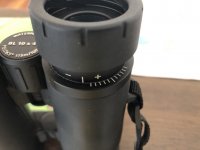pbjosh
missing the neotropics

First when I say wandering diopter, I mean a diopter that is clearly not functioning correctly - not a sneaky problem of having to adjust the diopter throughout the day a tiny amount depending on how tired you are, or having to adjust the diopter differently to achieve perfect near vs far focus, but rather a diopter that shifts over time. This had happened to me once about 10 years back. With perfectly corrected vision (ie, the diopter should have been in the center) I had to adjust it every day or two and after a month it was turned as far as it would go and still wouldn't achieve matching focus, yielding an essentially useless binocular.
I recently have this happening to another binocular (in this case a probably 10 year old but never used Minox BL I bought in a pinch after my primary bins developed a problem in the middle of a trip).
While I'm sure it likely (almost surely) varies due to internal design, I'm curious what is happening internally and if there is any chance that it is repairable, generally? I can imagine a few different designs that either shift a secondary focus lens entirely independently of the main focus mechanism or that would shift one of the focus lenses relative to the other in a perhaps lighter weight but slightly mechanically more complex design. The binocular in question is almost certainly not covered by a warranty (though I have sent in an inquiry) and is likely not worth the cost of a professional repair, but I am still curious what might be happening. I might well take it apart myself when/if it does become useless - less with the expectation of achieving a valid repair, more just for fun. I have plenty of experience with small parts and precision assembly (electronics and a few mechanical things) but no illusions that I will do anything more than play with it for a few hours, learn a bit, and then have a disassembled fishing weight instead of an intact fishing weight.
In any case, any comments / links to technical data / etc appreciated and if nothing else make for good discussion.
I recently have this happening to another binocular (in this case a probably 10 year old but never used Minox BL I bought in a pinch after my primary bins developed a problem in the middle of a trip).
While I'm sure it likely (almost surely) varies due to internal design, I'm curious what is happening internally and if there is any chance that it is repairable, generally? I can imagine a few different designs that either shift a secondary focus lens entirely independently of the main focus mechanism or that would shift one of the focus lenses relative to the other in a perhaps lighter weight but slightly mechanically more complex design. The binocular in question is almost certainly not covered by a warranty (though I have sent in an inquiry) and is likely not worth the cost of a professional repair, but I am still curious what might be happening. I might well take it apart myself when/if it does become useless - less with the expectation of achieving a valid repair, more just for fun. I have plenty of experience with small parts and precision assembly (electronics and a few mechanical things) but no illusions that I will do anything more than play with it for a few hours, learn a bit, and then have a disassembled fishing weight instead of an intact fishing weight.
In any case, any comments / links to technical data / etc appreciated and if nothing else make for good discussion.







